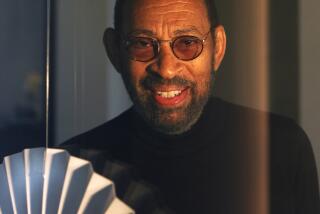MOVIE REVIEWS : Gregory Hines and His Dancing Friends Click in Nick Castle’s ‘Tap’
- Share via
In the dance routines of “Tap,” (citywide), Gregory Hines has a look of lazily ecstatic glee that’s almost irresistible. His every move and gesture seems to sing out: “Ain’t this a kick?”
When Hines breaks out into a crisp fusillade of taps, metal heels and toe clicking and ticking out the time patterns on the floor, it’s not just virtuosity, it’s casual virtuosity--seemingly beyond trying, beyond effort. Playing a rebellious hothead torn between the worlds of crime and show business, Hines is sensational.
Whether he’s bathed in the metallic blues of the opening jailhouse jive shots or the fiery reds and shimmering blacks of the stylized New York streets (lit MTV-style by Australian cinematographer David Gribble), Hines gives “Tap’s” central character, Max Washington, a smoky, simmering self-confidence.
He’s a hoofing Lochinvar pinned in an obvious plot. On the one side, there are his hoodlum friends outside: gangsters who want his second-story talents, including a trigger-crazy psycho (Joe Morton) slathering for a fight. On the other: eight sweet old hoofers, led by the obviously dying Little Mo (Sammy Davis Jr.) plus a ready-made wife and child (Suzanne Douglas and Savion Glover), all of whom want him to put on his legendary tap-dancing dad’s shoes and re-create the legend.
It’s an essentially corny role: a Hoofer Without a Cause. But Hines is a joy to watch, anyway. And so are all his fellow tapsters, from 63-year-old Sammy Davis Jr., as a sort of Walter Brennan of the dance floor, to the defiantly sexy Douglas to 14-year-old Glover (who starred in “The Tap Dance Kid” on Broadway) to a septet of spectacular sexagenarian hoofers who come together with Davis and Hines for an “impromptu” tap battle, giving the movie its highest moment.
The scene is a paean to professionalism and community--and old age and friendship as well. Supposedly the battle is a cutting session, but the dancers--Sandman Sims, Bunny Briggs, Steve Condos (the one white club member), Jimmy Slyde, Pat Rico, Arthur Duncan and Harold Nicholas (of the Nicholas Brothers)--turn it into a celebration. You feel that, underneath, they’re all rooting for one another. And so are we.
“Tap” was obviously conceived as a tribute to the whole mystique and tradition of tap dancing. Like his dad, Max is a dancing natural. He can translate the rhythms of the city around him into steps; he’s wired to the city’s heartbeat. But the script is constructed in unabashed movie-movie form. It’s another heavily archetypal story about stubborn oldsters trying to pass the torch to a somewhat reluctant youngster, a staple plot of Westerns and Army movies in the ‘40s and ‘50s. Also, in a way, it’s a riff on Coppola’s 1984 “The Cotton Club”: updating it and combining the old Hines and Richard Gere roles into a single character.
The writer-director, Nick Castle, is son of the Nick Castle who worked as a movie choreographer with, among others, Fred Astaire, Gene Kelly and Bill (Bojangles) Robinson. Perhaps inevitably, Castle Jr. presents tap dancing as a vanishing but precious art form, and tries to show Max as the prodigal son-carrier of that tradition, a nascent super talent who’s rejected his heritage but has the feet and soul to bring it back. Unfortunately, “Tap’s” climactic fusion of tradition and modernity--hooking Max’s shoes up to a synthesizer and amp, having him tap along with a rock group--doesn’t click.
But Castle, who showed both an essentially sweet temperament and a sensitivity to color and mood in children’s movies like “The Last Starfighter” and “The Boy Who Could Fly,” seems really intoxicated by the possibilities here. And, because the film delivers so well in the musical numbers--a touching rooftop Fred-and-Ginger number by Hines and Douglas, a rousing MTV style dancin’-in-the-streets routine--perhaps we can forgive the sentimentality, the obviousness, the lapses in logic. (Many of the best Golden Age musicals have them too.) “Tap” is a movie that tries to put an old-fashioned soul under a glistening, taut modern skin.
Hines has perhaps been limited by roles that made him too sweet and ingratiating, that played up his gentle, moon-eyed face. Here, Max Washington is a divided character, a sexy rogue, a bad-good guy. There’s an edge of violence to his scenes and, perhaps, because Hines’ features are never threatening in repose, the insolence gives his acting and dancing a liberating snap, ease and tigerish force. You can almost feel his delight to be there.
Maybe Sammy Davis Jr. should have let a little meanness or bitterness creep in too. Perhaps the most gifted movie musical star of the late ‘50s and ‘60s, Davis, excepting “Porgy and Bess,” never really got the right film vehicles or chances. So, you’d like to see more dancing between him and Hines; it’s the major frustration of the film.
But if Davis never really got his moment, Gregory Hines, here and now, gets his. Playing in “Tap,” (MPAA rated PG-13 for suggestions of sex and violence, language), he has the look of a performer who’s seized that moment, caught the beat, found his time. There’s a deftness, a cocky swagger, almost a glow around him. When the spotlight pours down, and his feet begin to fly, he has the vibrant, blessed aura of a dancing man on a roll, alive in the rhythms and talking with his toes.
More to Read
Only good movies
Get the Indie Focus newsletter, Mark Olsen's weekly guide to the world of cinema.
You may occasionally receive promotional content from the Los Angeles Times.









